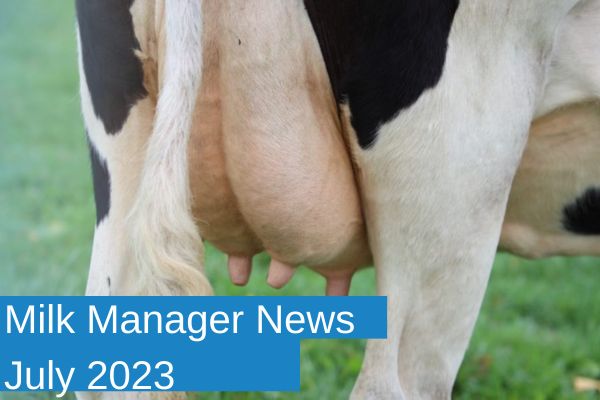MMN July 2023 – Keeping Mastitis Under Control in Summer
11 July 2023Mastitis is one of the biggest causes of economic loss in the dairy herd and can be even more prevalent during the grazing season. Exposure to new bacterial pathogens and changing environmental conditions can increase the risk of infections occurring. Figures from Kingshay suggest that an average case of mastitis in a lactating animal costs £386. Furthermore, the annual emergence of nuisance flies can lead to summer mastitis infections, particularly in non-lactating cows and heifers.
Mastitis occurs when bacteria enter the udder (usually via the teat canal) and infect the mammary tissue. Clinical symptoms include a hot, swollen and painful udder, clots in the milk and loss of production. Sick animals may have a high temperature, loss of appetite and become isolated from the group. Severe cases can cause permanent udder damage and lost quarters. Subclinical infections generally go unnoticed and are usually only detected through routine milk sampling.
Causes
- Housing: Dirty bedding and soiled passageways can harbour harmful bacteria including Streptococcus uberis and E. coli.
- High temperatures: Heat stress can compromise the immune system of the cow, making her more susceptible to infection.
- Poor hygiene practices: Poor sanitation of teats and milking equipment can increase cow-to-cow transmission, particularly by contagious pathogens such as Staphylococcus aureus.
- Flies: The sheep head fly (Hydrotoea irritans) is responsible for transmitting the bacteria Trueperella pyogenes, known to be the main cause of summer mastitis. The fly is most active in July, August, and September.
- Teat damage: Cracked or sore teats are more likely to attract flies. Damaged teat ends are less effective at preventing bacteria from entering the teat canal.
Treatment
Intramammary antibiotics are typically used where the infection is mild. Injectable antibiotics are used in more severe cases alongside anti-inflammatories to counteract swelling and reduce temperature. Pre-milking the infected quarter prior to treatment is advised to enable the antibiotic tubes to reach a larger area of the udder. In extreme cases, teats may need to be split open to drain the udder of infection. Toxic mastitis cases will require fluid therapy and immediate veterinary attention. It may be advisable to obtain a milk pathogen test to identify the cause of the infections and the most effective treatments.
Prevention
- Keep cubicles and lying areas clean and dry. Frequently scrape passageways to avoid muck pooling. Trim tails and udders. Dirty tails will fling manure around the building when cows are irritated by biting flies. Rotate pastures frequently to avoid a build-up of bacteria.
- Ensure cows are given adequate shelter, ventilation, and access to water at all times to minimise heat stress.
- Pre-dip and wipe teats prior to milking, paying particular attention to the teat end. Carry out routine milk sampling to identify high somatic cell count animals and treat accordingly. The California Milk Test can be used to identify problem quarters. Disinfect clusters between each animal to prevent transmission. Dry cow therapy should be administered in as sterile conditions as possible and teat sealants should be used in conjunction with antibiotics. Repeat antibiotic treatments may be required with extended dry periods. Vaccinations can also be used to help prevent coli infections.
- Avoid grazing near wet areas and woodland. Control flies using pour-ons. Treatments should be repeated every 4-8 weeks for maximum effect. Apply half the dose to the udder area (using gloves) for better coverage. Stockholm tar, although messy, could be used on farms with a history of summer mastitis. Parasitic wasps can be released to reduce the fly population and disrupt the breeding cycle.
- Regularly maintain milking equipment to prevent over-milking, which can lead to teat damage. Use conditioning teat dips and udder balms to prevent dry cracked skin.
Good management practices, hygiene, fly control, and routine milk sampling can reduce the incidence of mastitis during the summer months. When incidences do occur, it is important to work with a veterinarian to identify the main causes in order to administer the most appropriate treatments.
marcus.fox@sac.co.uk; 01539 889990
Sign up to the FAS newsletter
Receive updates on news, events and publications from Scotland’s Farm Advisory Service

